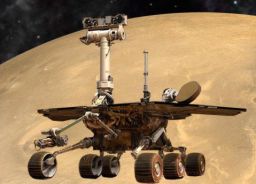A.J.S. Rayl • Mar 31, 2011
Mars Exploration Rovers Update: Spirit's Silence Haunts, Opportunity Roves on to Endeavour
The Mars Exploration Rover mission experienced a month of highs tempered by one haunting low as it neared completion of its 87th month of a three-month tour this month. While Opportunity wrapped up its work at the youngest, freshest crater the rovers have explored to date, Spirit remained silent as the point of maximum sunshine for the Martian year came and went, further dimming once high hopes that the rover would phone home and rove on as summer settled on the southern hemisphere of Mars.
Spirit is parked to the west of an old, circular volcanic plateau called Home Plate, its right wheels partially embedded in sandy soils along the edge of a shallow crater in an area called Troy, with 7730.50 meters (4.80 miles) on her odometer. It's been more than one Earth year now since Spirit last communicated. Prior to that, power output from the rover's solar array had been waning, and engineers expected it would go into a low-power hibernation mode.
In the preceding three Martian winters, Spirit had been able to park on north-facing slopes to angle its solar panels toward the Sun. But this past winter, with two of its six wheels no longer working, the rover was unable to maneuver much in its sand-trap location. Although in February 2010, the rover had begun making notable progress in getting unstuck, it wasn't able to get a favorable tilt for its solar panels before Martian winter gripped the site in Gusev Crater.
The JPL Radio Science Team continued throughout March listening for a beep, and sending out commands to nudge the rover through NASA's Deep Space Network (DSN), aided by a little help from a friend, the Mars Odyssey orbiter. "It's growing more and more evident now that there is a chance we're not going to hear from Spirit again," acknowledged Steve Squyres, the principal investigator for the rovers, during an interview earlier this week.
The MER team, however, is not quite ready to give up, being taught by the rovers long ago to never say 'never.' "Nobody has written off Spirit yet," said Scott Maxwell, Mars rover driver team lead, at the Jet Propulsion Laboratory (JPL), where the rovers were born, and which is the site of their mission control. "We continue to do our engineering due diligence, and we still have some cards up our sleeve, and we are still hopeful we will hear from our girl."
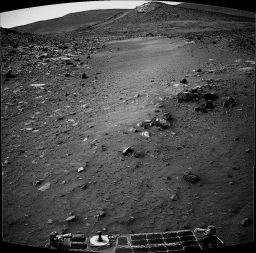 Spirit's view - if
Spirit's view - ifIf Spirit is still alive, this is her view, looking to the south of Home Plate toward the geologic formations she was to have visited next: Goddard, an irregular, 45-meter-wide (150-foot-wide) bowl, and the clearly visible Von Braun, a steep mound to the center right in the image. Credit: NASA / JPL-Caltech / Cornell / processed by Stuart Atkinson
The radio team has been systematically sending out electronic 'nudges' over a range of frequencies and a range of local solar times on Mars to cover the possibilities that the Spirit's receiver has degraded and / or that its clock has drifted significantly since it went into hibernation in March 2010.
This month they upped the ante in the bid to make contact with Spirit, and began following more aggressive strategies designed to widen those ranges and address more than one problem on the rover, a plan announced in the MER Update last month.
"There are so many things that will keep us from ever hearing from this vehicle again – that lack of signal is not diagnostic of any one thing," said Bill Nelson, chief of the MER engineering team, from JPL. "While we think we have exhausted explanations of mere degradation or off-set due to temperature – though of course we've had no data to guide us for the better part of a year – at this point we still have things to do, including some less likely, but still possible scenarios through which we might be able to figure out if something's broken, and/or make contact with Spirit. We're doing everything we can do to shake this spacecraft everyway we can think of to try and get it to respond to us."
On March 15, JPL issued an official notice that the new strategies were being implemented. "We are focusing on those faults that are recoverable," John Callas, MER project manager at JPL, said during an interview yesterday. "They pretty much all fall in the area of telecommunications."
The MERs feature both an X band communication system and an ultra-high frequency (UHF) system. The new strategies involve commanding extra-long, UHF relay passes to account for possible rover clock drift or clock error and to make the rover responsive to UHF relay if it is has experienced a mission-clock fault, as well as turning on the backup solid-state power amplifier (SSPA), in case the primary X-band transmitter has failed. "We've been doing all combinations of the receiver on one and the transmitter on the other and have come up with a list of seven different combinations that we are trying and we want to try each one multiple times," said Callas. "That's the list that we're working through."
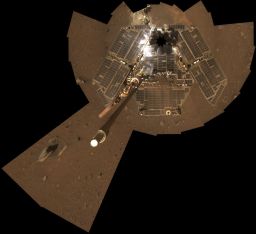 When Spirit dust was last 'blown away'
When Spirit dust was last 'blown away'From Sols 1976-1978 (July 24-27, 2009) Spirit tipped her panoramic cameras down to acquire a self-portrait. The solar arrays are shown here cleaner than they had been in years, the result of a lucky, strong gust of wind. "The vertical projection used here produces the best view of the rover deck, though it distorts the ground and antennas somewhat," noted Pancam Instrument Lead Jim Bell, who also happens to be president of The Planetary Society. "The eight-pointed star shape near the front of the rover (top of the image) marks the location of the camera mast, which is out of view of the Pancam atop the mast." Credit: NASA / JPL-Caltech / Cornell
Spirit may be covered in a blanket of the powdery fine Martian dust that swirls around and is lifted by gusts of winds high into the atmosphere during the Martian spring and summer. One thing the rover could really use – yestersol – is a blast of Martian wind to clear her solar panels. It could be that the rover is just so dusty that she can't take in enough sunlight fuel to power up. Or it may be that something or some things have broken and she's already gone to robot heaven.
Given that Spirit has been exploring the Red Planet for so long, defying all the odds, and delivering above and beyond every dream, despite always having the harder road to hoe, it's almost hard to grok that the end day is coming, though everyone on the team and all those diehard followers of the mission own the reality.
"They're not immortal. We've known that all along," said Squyres. "We're so fortunate to still be doing stuff on Mars after all these years. The way I look at it is every day is a gift."
A "death" announcement could come as early as late April, said Callas. That, however, is not a hard and fast estimate. "Obviously, at some point you've got to say, 'Okay, we've done our due diligence.' And we're getting close. The thing is, as with so many of these technical issues, as you go into it [the new strategies], you discover new things," he pointed out. "So right now around April 20 is when we will finish the last set of combination failure recovery commands, and then there are some less likely scenarios things we'll try. But, we may learn something in the next couple of weeks and there may be something else we want to try beyond those."
The new strategies will continue in earnest until about May 2; thereafter, the team will continue a low-level of recovery activity through the end of the calendar Earth year.
As the mission roves toward its 88th month on Mars, there's no getting around the fact that the prospects for Spirit are becoming bleaker with every passing sol or Martian day. Still, pulling the plug will be difficult for this team. Only brave faces are projected. "We've had a long time to get used to this," said Squyres. "We are seven-plus years into a 90-sol mission, so overall we're doing fine."
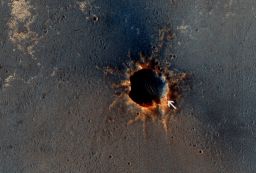 Opportuntiy at Santa Maria
Opportuntiy at Santa MariaThe High Resolution Imaging Science Experiment (HiRISE) camera on the Mars Reconnaissance Orbiter acquired this color image on Mar. 9, 2011, of Opportunity perched on the southeast rim of Santa Maria Crater. The rover is the bluish speck at about the 4 o'clock position on the crater rim. North is up. Rover tracks are visible to the west of the crater. Credit: NASA / JPL-Caltech / UA
Individually, however, it's personal and team members, each in his and her own way, is feeling their own feelings and preparing in their own way. That noted, it is not over yet."The team has a huge emotional connection to this rover and they want to give it every opportunity," said Callas. "They want to try every measure."
By all accounts, is only right and fair after all Spirit has given to her team, to planetary exploration and the science books on Mars, to her fans – and to her country and the world as an ambassador who only made us proud every rove of the way. "Spirit deserves our best effort," said Squyres. "And we are going to exhaust every possibility."
If the ops crew discovers nothing through the intensified process of reaching out and listening, which is a strong possibility, Spirit's mission may effectively be brought to an end without even a hint as to what happened, what it was that took the robot field geologist out. Not knowing will be the hardest part for many.
On the other side of Mars, at Meridiani Planum, Opportunity finished up the last of its science assignments at Santa Maria Crater, and headed out. "We are on the road again to Endeavour," announced Squyres.
The team did, however, command the rover to divert off course slightly to take some pictures of some intriguing boulders. With that assignment completed a couple of sols ago, Opportunity is now back on Meridiani "highway," pedal to the metal, following the charted course to the southeast.
Endeavour Crater, this rover's next major destination, now just under 6 kilometers (about 3.73 miles) away. "The terrain ahead is just as flat as a pancake and we expect to be able to go full steam ahead from here on out," said. Maxwell.
 The art of Endeavour
The art of EndeavourOpportunity took this image of the Endeavour hills earlier this month, and Stuart Atkinson, of UnmannedSpaceflight.com,turned it into this artistic image. "The Sun is "added," and the colours are all fake, and it's tweaked to within an inch of its life, poor thing, but apart from that it's an accurate view," Atkinson notes with a smile.Credit: NASA / JPL-Caltech / Cornell / S. Atkinson
In other rover news, MER was still very much in the spotlight during the 42nd Lunar and Planetary Science Conference held March 7-11 at the Waterway Marriott Hotel and Convention Center in The Woodlands, Texas, just north of Houston.
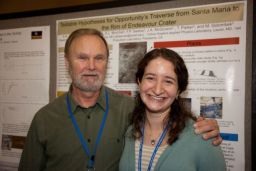 Ray Arvidson, Abby Fraeman
Ray Arvidson, Abby FraemanAbby Fraeman, a second year grad student at Washington University St. Louis, and a former Red Rover Goes to Mars student astronaut, came of age with the Mars Exploration Rovers and is now conducting science research for the mission. At a poster session at the 42nd Lunar and Planetary Science Conference, she presented a poster on Opportunity's traverse from Santa Maria Crater to Endeavour. The route the rover is now taking to a location called Cape York, on the rim of the crater, has been charted as a result of the detection of the signatures for hydrated sulfates and phyllosilicates by the CRISM spectrometer onboard the Mars Reconnaissance Orbiter. Credit: John Blackwell
Ray Arvidson, the deputy principal investigator for the rovers, and a frequent source for the MER Updates, presented a paper on Opportunity's recent findings, covering the atmospheric dynamics, Aeolian ripples, meteorites, ejecta cobbles and boulders, and sedimentary bedrock the rover has investigated (covered here in past months here), with a look ahead to the long-anticipated arrival at Endeavour Crater. "Accessing the hydrated rocks near Endeavour's rim and the clay minerals on the rim proper will open a new chapter for Opportunity," he noted. Squyres, Scott L. Murchie, the principal investigator of the CRISM spectrometer onboard the Mars Reconnaissance Orbiter (MRO), and others contributed to the paper.
Arvidson joined two of his students who were presenting posters on Opportunity's travels during one of the conference's poster sessions. Another familiar face, Abby Fraeman, who was one of the student astronauts chosen to join the science team at JPL to participate directly in the daily operations of Spirit and Opportunity in early 2004, as part of the Red Rover Goes to Mars educational project of The Planetary Society, is now a second year graduate student at Washington University St. Louis (WUSTL), where she has again been working on the mission. She presented a poster on Opportunity's current traverse from Santa Maria Crater to Cape York, charted as a result of CRISM detections of the signatures for hydrated sulfates there, and phyllosilicates further south at Cape Tribulation.
"You can see these plateaus around the edges of Cape York that are horizontal and we're hoping to find out if they were deposited horizontally by some groundwater system that caused them to sink down," she said. "And another question we want to answer is: 'Why are we starting to see things with CRISM that we haven't seen before?'" Fraeman wrote the presentation along with Arvidson and other researchers familiar to MER followers, including Murchie, of Johns Hopkins University, and JPL's Tim Parker and Matt Golombek.
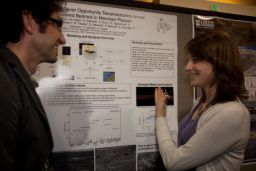 Lauren VanDyke explains ARTEMIS
Lauren VanDyke explains ARTEMISLauren VanDyke, a junior at the University of Washington St. Louis, explains the Adams Rover Terramechanics and Mobility Interaction Simulator - more simply known as ARTEMIS - to an attendee during an evening poster session at the 42nd Lunar and Planetary Science Conference held in early March in The Woodlands, Texas. ARTEMIS is a multi-element, dynamic 3-D model that is being used now to chart the best paths for Opportunity to take to explore Cape York. Her advising professor is Ray Arvidson, the MER deputy principal investigator. Credit: John Blackwell
During that same poster session, Lauren VanDyke, a junior at WUSTL, presented a poster on the Adams Rover Terramechanics and Mobility Interaction Simulator - more simply known as ARTEMIS. This multi-element, dynamic, 3-D model was initially developed to help extricate Spirit from the sandtrap where the rover still sits. Now, it is being used to chart the best paths for Opportunity to take around Cape York and other areas on Endeavour's rim. "This 3-D model is about as accurate as you can get features all of the parts on the rover," she pointed out. "We're really focusing now on areas at Endeavour where Opportunity may have mobility issues."
In an intriguing presentation, Steve Ruff, of Arizona State University (ASU), the lead scientist working with Spirit's miniature thermal emission spectrometer (Mini-TES), dared to mention the "L" word in presenting his paper, hypothesizing that brine from an evaporating lake in Gusev crater, perhaps filled repeatedly, infiltrated Adirondack class rocks, such as Comanche, and precipitated abundant magnesium and iron-rich carbonates. Based on evidence from the Mini-TES and the microscopic imager (MI) pictures, Ruff suggested that the distinctive morphology of the eroding Comanche outcrops may be a manifestation of dissolution of carbonate over time and also may be expressed in terrain nearby and similar "rubble terrain" that is widespread on the floor of Gusev Crater.
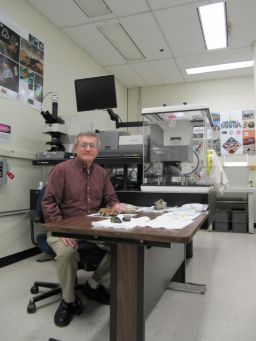 Richard V. Morris in his lab at JSC
Richard V. Morris in his lab at JSCDick Morris is a senior planetary scientist and manager of the Spectroscopy and Magnetics Laboratory down on Earth at NASA's Johnson Space Center (JSC). By all accounts, it was Morris' persistence that led to the MER team's discovery of carbonates on Mars.
Credit: NASA / JSC
Robert V. Morris, manager of the Spectroscopy and Magnetics Laboratory down on Earth at NASA's Johnson Space Center (JSC), who was the MER science team member who sleuthed the carbonate story of Comanche, presented a paper on his team's research into a terrestrial analogue for the Comanche carbonate.
"A hydrothermal origin for the Comanche carbonate was inferred by analogy with laboratory experiments and with a carbonate occurrence within the Bockfjord volcanic complex on the island Spitsbergen, (Svalbard, Norway)," Morris said. That work on the Spitsbergen carbonate as a Mössbauer analogue "strengthens" his prior interpretation that the Comanche carbonate is secondary and hydrothermal in origin."
Still, the rovers have not found a whole lot of carbonate bearing rocks and for decades the carbonate expected to be on Mars had been nowhere to be found.
James Wray, a grad student at Cornell, presented a paper that may offer a reason why. In outlining evidence for regional, deeply buried carbonate-bearing rocks on Mars, some as much as 5 kilometers beneath the surface as a result of huge impacts and bombardments, he said: "Early burial could have protected these carbonates from possible later surface acidity and could help explain why few large exposures of carbonate-rich rocks have been identified."
As always, there was so much Mars to take in at the conference, it is impossible to even begin to adequately summarize even the MER highlights here, but those brisk summaries offer a glimpse into just how much science is emanating from the rovers' travels.
Spirit from Gusev Crater
The general consensus among the MER ops crew remains that in the sols following Spirit's last communiqué on March 22, 2010, the rover tripped a low power fault and went into a hibernation mode, as programmed. Since there has been no ground data returned since then, and only model predictions as to temperatures and conditions at the site, what has happened in the year since is not known. Guesses are, at this point, just guesses, and it's now been just about one Earth year that the MER team has been trying to regain contact.
 Spirit at Troy
Spirit at TroySpirit, which is about the size of a golf cart, can be seen here on the shoulder of Home Plate in this artist's rendition showing the rover's position, where she became mired in the sands of Ulyssess in an area the team dubbed Troy back in May 2009. The panorama was taken by the rover on he Sol 743 as she descended from Husband Hill toward Home Plate. Home Plate is circular plateau occupying the center of the image; click to enlarge to see the rover in the valley to its right.
Credit: NASA / JPL / Cornell / Glen Nagle
Although there is no hard evidence, it is safe to assume that the solar energy available at Spirit's location has been increasing steadily over the last six months or so through spring and early summer. But the peak of solar insolation – the sunniest day of summer – came and went in the southern hemisphere of Mars around March 10th, and with no beep from Spirit, the hopes of hearing from her again are fading. Technically, since peak temperatures lag by two to four weeks, Spirit actually should be experiencing the warmest temperatures about now. But that is, as Nelson mentioned during a recent interview, "a pretty minor point." Emotions among team members are becoming more and more measured.
The MER team really hadn't expected to hear from Spirit until late last August at the absolute earliest, and sometime next month at the latest, but it has been listening for the rover's recovery beep tones since April 2010. In fact, DSN antennas in California, Spain, and Australia have been listening daily for any sound of rover life.
Since late last year, the MER team, with the technical expertise of the JPL Radio Science group, has also sent commands, reaching out to elicit a response from Spirit so that even if she tripped a master clock fault and lost track of time, or if her receiver degraded in frequency response, she would know to wake up from her presumed hibernation.
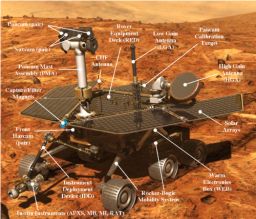 MER body parts
MER body partsThe Mars Exploration Rovers are robot field geologists that were designed with parts to substitute for the organs all living creatures would need to stay "alive" and able to explore, as well as some super-human powers. Spirit and Opportunity, for example, each have a body that protects its "vital organs;" brains to process information; temperature controls, including internal heaters, a layer of insulation, and more; a "neck and head" formed from a mast for the panormaic cameras for a human-scale view; eyes and other "senses," such as cameras and instruments that give the rovers information about their environment; an arm to extend its reach; wheels and "legs," necessary parts for mobility; and energy sources in the form of batteries and solar panels; and antennas for "speaking" and "listening."Credit: NASA / JPL-Caltech
With most of her heaters turned off through the harshest Martian winter, one thing is certain: Spirit experienced colder internal temperatures than in any of its three previous winters on Mars.
"All of the rover's equipment has been subjected to much colder temperatures during this low power condition than was ever expected in flight," Nelson pointed out. "We think we came right down to the allowable flight temperature (AFT), the minimum AFT, for this hardware, which is -55 Celsius. We don't think we seriously went below it – maybe a couple of degrees – predicts were about -56 to -57 C during parts of the night and somewhat warmer during the day. But it's hard to say. This was all predict, but the rover certainly experienced a cold soak and extremely low temperatures for much longer than was ever planned. Not only were components subjected to thermal expansion and contraction every sol, but the colder temperatures made for greater contraction which might have overstressed bond wires inside the integrated circuits or component leads of the integrated circuits and other components."
The well below freezing cold for a sustained period, over months, could have damaged any number of electronic components, any of which would prevent the team from reestablishing communication and which would mean curtains for the rover. Given the cold, cold temperatures on Mars, it's possible, and may even be probable that some components have failed.
"There are two oscillators that we've been concerned with – one of them is basically the spacecraft clock located on the telecomm service board in REM [Rover Electronic Module], and the other, a much higher frequency oscillator is for the frequencies that we transmit, in the SDST (small deep space transponder) – and that is the X band transmitter and receiver," Nelson offered. "That SDST, however, is not the whole of the transmitter. "Its output is boosted to the required level by the solid state power amplifier (SSPA) before it's sent out the horn."
Most radios feature several key components: a frequency generator; a modulator that essentially takes the data and the radio frequency and merges them together; the exciter, which usually boost very tiny signals to low power; and the power amplifier that takes that low power level signal and boosts it up to its final, higher power level.
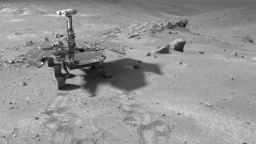 In happier times
In happier timesTo create this image, a computer simulation of Spirit was dropped into a Navcam panorama captured on Spirit's Sol 438, as the rover was just beginning her hike up into the Columbia Hills. Source Credit: NASA / JPL-Caltech; Rover model by Dan Maas; synthetic image by Koji Kuramura, Zareh Gorjian, Mike Stetson and Eric M. De Jong
The MER X band radio features two oscillators: the ultra stable oscillator (USO) and an auxiliary oscillator. "The USO is tied into the receiver, and so it basically can phase-lock and track the uplink signal, and that causes the transmitter to repeat the uplink frequency, except shifted a little bit in frequency and in phase," Nelson explained. "We use that for coherent tracking and it's also known as two-way, “because the same frequency, the uplink, controls both the uplink and downlink signals."
Additionally, there is another mode, where there is no signal, because the uplink hasn’t reached Mars yet, or the signal has reached Mars, but it’s the wrong frequency. "In either of these cases, the downlink frequency is determined by the auxiliary oscillator, an independent oscillator that has no connection to that uplink,” Nelson said. “It is also fairly temperature sensitive, fairly in this context not meaning a lot but certainly a lot more than the USO. Usually we’re on the aux oscillator because no uplink is being transmitted or, if it is, it hasn’t arrived at Mars, or else it’s so far off in frequency that the rover’s receiver can’t pick it up. Otherwise, when there is an uplink and it’s on the right frequency, the downlink frequency is determined by the SDST’s voltage-controlled ocillator (VCO).”
So, the engineers have been considering and trying to work a number of possible failure modes. "One is that the USO has failed or the receiver has failed and we're transmitting on the auxiliary oscillator frequency, and we're listening for that," Nelson informed. "But because it's so temperature sensitive and since we don't know really know what the temperature is at the Gusev site, there's about a 100-kilohertz range in which we have to listen. That's a pretty wide range."
While every oscillator is sensitive to both circuit components and to voltages and currents, good design can keep those sensitivities low. The rovers' USO is an excellent example of good design, and thus those effects are very small. That means the rover engineers have no real reason to believe this oscillator actually broke. Of course, there is no way of knowing if it or another component is broken or just degraded unless they can provoke a response. "But we do know that temperature is one that everything is subject to," Nelson noted.
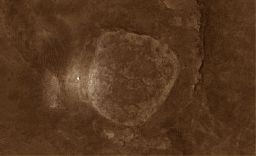 Spirit's location
Spirit's locationIn this picture of Home Plate, taken by the HiRISE camera onboard MRO, you can easily see the stark white figure that is Spirit to the left (west) of the geologic formation in this image enhanced by rover poet Stuart Atkinson. "It's just a screengrab from the excellent HiRISE IAS Viewer," he said. "I added some colour, then highlighted the position of Spirit. If you look carefully you can actually see bright trailing leading to Spirit - this is the result of the (right front) broken wheel being dragged through the dirt, unearthing brighter material beneath." For more of Stuart Atkinson's enhanced images, poems, and thoughts. particularly of the targets being investigated by Spirit's twin, Opportunity, check out "Road to Endeavour" at: http://roadtoendeavour.wordpress.com/Credit: NASA / JPL-Caltech / UA / S.Atkinson
As a result of those cold Martin winter temperatures, they have been thinking that the base frequency of the USO may have shifted. " We don't know, but if that's true, then we have to hunt for that frequency, and we have gone to using a wider frequency range on our uplink, with the 'sweep' part of the sweep-and-beep," Nelson said. "That sweep takes the uplink frequency and runs it above and back below, and back to where we think the rest frequency of the oscillator is."
The up, down and back sweep was the original sweep of the sweep-and-beep. "We now start high, sweep down then hold like this: \__," Nelson clarified in a descriptive email. "Commanding is done at the bottom. This avoids the redundancy of sweeping through a given frequency twice. It lets us shorten our sweep-and-beep time so we can guarantee at least one command should be received regardless of when the rover wakes up."
The USO has a tracking loop that will follow large changes in the uplink frequency; but it can’t follow the uplink until it first latches onto it. "This process, called 'acquisition,' requires the ground crew to get the uplink frequency within the rather narrow acquisition range of the loop," Nelson said. "We use the sweep to move the uplink frequency through where we believe the acquisition range to be. If we’re right, the USO will 'latch onto' the signal and follow the subsequent changes.
In essence then, the rover's ground crew has estimated what they think the temperature is onboard Spirit and have been sweeping above that and below that, and then bring it back to what they think the rest frequency is. "We're now assuming that the rest frequency is off-set from where we think it is, and then we sweep high and low above that, with tiers about 10 kilohertz apart – between +30 and -90 kilohertz, a process known as frequency tiling," Nelson said. "We try one frequency, and if that doesn't work, we move to the next tile above it or below it and try that frequency," he explained.
In addition to the frequency tiling, the Spirit ops crew has been time tiling or commanding over a much wider time range. "Manufacturers' specs suggest that the oscillator that controls the spacecraft clock may have drifted as much as 30 minutes plus or minus," said Nelson. "So in addition to frequency tiling, we've also been doing time tiling, basically trying to command much earlier and much later than the nominal times we would expect on the spacecraft. We began some weeks ago running these to about an hour before we think the vehicle may be awake to about an hour or so afterward and then expanded that range to be much wider still."
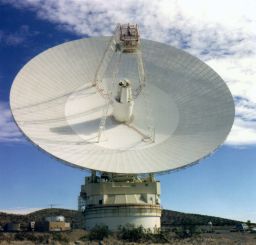 70-meter dish at Goldstone
70-meter dish at GoldstoneFront view of the 70-meter dish, also known as DSS-14, at the Deep Space Communications Complex at Goldstone, CA. Located in the Mojave Desert, Goldstone is part of NASA's Deep Space Network, which provides radio communications for all of its interplanetary spacecraft and is also utilized for radio astronomy.Credit: NASA / JPL
In fact, Nelson said that they had been looking at commanding over five, six hours in a given sol. "Of course, the DSN is servicing a lot of other people as well, so we haven't always gotten the station allocation to command that much every day, but we get allocation to command early one sol and later in another sol and maybe down the center on another and we've taken advantage of what we can get," he said.
"We've got these two oscillators in the radio, both of which are temperature sensitive, and, while it's highly unlikely, we could have had a break or something go wrong in the temperature compensation of the USO, and we've been kind of working around that, and working around the fact that we could have had different temperatures from what we think," Nelson pointed out. "But until a couple of weeks ago, we hadn't really been going on the theory that anything is outright broken."
With peak solar energy production for Spirit having occurred on or about March 10, however, and with most of the non-broken scenarios pretty much exhausted, the rover ops team changed strategies, switching to communication strategies designed to address the probability that Spirit has experienced more than one problem. A review panel, comprised of engineers who worked on the design of the rover, including Mark Adler and Rob Manning, encouraged them to become more aggressive.
On March 15th, that more aggressive plan was initiated, confirmed Callas. The new strategies included commands for the rover to be receptive over UHF relay to hailing from the Mars orbiters for extended periods of time, and to use the backup transmitter SSPA on the X band on the rover, which has never before been used in flight. "The commands we have been sending should work in a multiple-fault scenario where Spirit's main transmitter is no longer working and the mission clock has lost track of time or drifted significantly," Callas said.
The X band telecommunications system, however, is fairly complicated. There are a number of components involved – including a coaxial switch to select one of the two output amplifiers or SSPAs, either the primary or the back-up, and a waveguide transfer switch, which switches between the low gain and high gain antenna – all of which have to work. If any of those fail, then the system doesn't work.
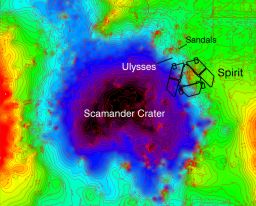 Topographic map of Spirit's location
Topographic map of Spirit's locationThis topographic map of Spirit's location at Troy represents low elevations in black, purple, and blue and high elevations in red. It was developed based upon Spirit's camera images of the location, taken before it got mired at Troy. The topographic model has had a regional slope removed, which reveals that Spirit's left wheels are sitting inside a subtle depression that the team has named Scamander crater. The right-side wheels are outside the depression.Credit: NASA / JPL-Caltech / Ohio State University
Although they really have no way of knowing unequivocally if those commands even got in, "if it worked, we should have seen a signal," said Callas. Following the switch to the back up SSPA, they "did the very long UHF windows," he said. In coming days, they will be commanding a very long, receive only window on the X band to see if the receiver works. "Say the transmitter is broken on the rover and the UHF receiver is broken, but the X band receiver can listen and respond to commands to keep the rover awake all day. Then we'll send a second command, when we know there is an orbiter overhead, to turn on the UHF transmitter. This gets at the question of whether our X band transmitter is broken and UHF receiver is broken," he explained.
"Normally, the UHF system requires both a receiver and transmitter to work together for it to communicate with an orbiter," Callas continued. "Maybe the UHF receiver is broken and maybe the reason we haven't heard from the rover on X band is because the X band transmitter is broken. Maybe the rover has been hearing us all along on X band, so we're going to try that. That's sort of the last new thing to try on this list of combinations we've been working on since the middle of the month."
If this does elicit a response from Spirit, what could the rover actually be able to do from here on out with such hampered communications?
"If the receiver on the X band is working and the UHF transmitter, there are things we can do to recover data from the rover," Callas assured. "We would use the UHF in what's called the ‘unreliable mode,’ which means we have to be much more sophisticated about our timing of the relay, and there is likely to be data drop-out, but there is still reasonable expectation you could get meaningful science data that way."
 Comanche: Bearer of Carbonate
Comanche: Bearer of CarbonateSpirit collected data from Comanche back in 2005 that proved to reveal the presence of carbonate, a sure sign of past water. That's what the MERs were sent to Mars to find. Here, Comanche is the dark reddish mound above the center of the view. The image is presented in false color, to make different materiasl in its make-up easier to see. It combines three separate exposures taken through filters admitting wavelengths of 750 nanometers, 530 nanometers and 430 nanometers. The main Comanche outcrop is about 5 meters (16 feet) from left to right from this perspective. The paler material visible at bottom right is part of another outcrop, Algonquin.Credit: NASA / JPL-Caltech / Cornell
While ‘reliable mode’ uses an ACK-NAK (ACKnowledge-Negative AcKnowlege) protocol, also called an ARQ (Acknowledge, ReQuest) protocol, that acknowledges receipt of each packet of data or requests a retransmission of a lost or corrupted packet, ‘unreliable mode’ does not use a transmission protocol. It just sends successive data packets for the duration of the window,” explained Nelson. “If any are lost, the ground crew must identify them and manually request retransmissions. The advantage is that when in unreliable mode, the UHF receiver doesn’t get involved – there’s no listening for ACK or NAK.”
Callas said that the main list of attempts, as outlined above, should complete around April 20. However, if those efforts fail to rouse the rover, there are a few additional "cards" the team wants to play as part of its due diligence in attempting recovery of their robot field geologist.
"I still need to get with my engineers, because they've been going over this and sharpening their pencils and finding a few more things here and few more things there, but there are a few more things we want to try," Callas said.
The latest completion date as of today is May 2nd. This date was set to compensate for some lost tracks and any other missed opportunities. It looks now like the only thing that will change that date is hearing from Spirit. "We have some other somewhat less likely things to command, where we basically just kind of give it a shot," elaborated Nelson. "These are the unlikely failure scenarios," he admitted, "but we're trying everything we can think of."
It actually could be that Spirit just doesn't have the energy, unable to take in enough sunlight fuel to keep on keepin' on. But the clock is ticking on that front too. "We passed the peak of solar input earlier this month and our chances for another cleaning event are diminishing as time goes forward," said Squyres. "The peak rolls off gradually, so you can't read too much into that right now, but the curve is not still going up."
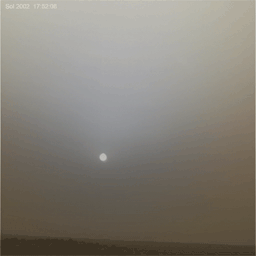 A dusty sunset on Mars
A dusty sunset on MarsWhile bogged down at Troy, Spirit looked westward on the evening of sol 2,002 to watch the Sun set. Before it reached the horizon, the Sun vanished into dust kicked up in a regional dust storm. This animation is composed of 11 Pancam frames captured over 12 minutes; artificially colorized to add drama. Now, the Sun may be setting on Spirit's mission.Credit: NASA / JPL / Cornell / animation and colorization by Peter Greutmann
Suffice to say, the team will carry on for Spirit until there is nothing left to do. "We want to close out all those possibilities, however unlikely, to make sure there isn't something completely off the wall that could explain things," Callas confirmed. "At the same time, I think good engineering judgment tells you at that point, it's unlikely to be successful."
If no signal is heard from Spirit by early May, the writing is on the wall: Spirit's mission will come to and end and the team will shift to single-rover operations, continuing to operate Spirit's active twin, Opportunity. Even after the plug is officially pulled though, the team is slated to continue a low-level of recovery activity through the end of the calendar year, during which time they will try "a whole list of what we call Hail-Marys," informed Nelson.
"Our little drama queen is taking us right down to the wire," sighed Maxwell. "You remember when she landed and we were out of contact with her for a little bit longer than we should have been, and then she piped up and all was fine. My hope is that will be true again. We have on the high side a half a dozen [strategies] still left to try," he noted. "We've been through a lot of ups and down with this rover and we do continue to be hopeful. That said, we are past the time when we have the best odds of hearing from her. I'm not going to lie to you: the odds are not as good as I once thought they were, but the odds have not diminished to zero or nearly zero either. So while there is still a chance, we're going to give her every possible chance. Given everything she has done for us, she has certainly earned that right. We owe it to her – and we're going to give her those chances."
Squyres agreed: "We need to exhaust every possibility. The rover deserves our best efforts. It will take some weeks, and we'll see how it goes. We also have to kind of realize that sooner or later – once we've tried everything we can try – it will be time to focus our energies on Opportunity."
 Husband Hill Summit Panorama
Husband Hill Summit PanoramaNearly a full Martian year after landing on Mars, Spirit reached the summit of Husband Hill, the first robot to climb a "mountain" on Mars, or any other planetary body beyond Earth. Spirit captured the 653 images required for this panorama between her Sols 583 and 586 (Aug. 24 to 27, 2005). This was then the largest panorama ever shot from either rover, including the entire deck of the rover. The full-size panorama spans 22,348 pixels in width and is available at the Planetary Photojournal.Credit: NASA / JPL / Cornell University
It's hard to know exactly how this team, which is incredibly tight-knit, is taking this. "JPL has a lot of introverted people and so we keep our emotions inside," noted Callas. "And people are busy. We're busy trying to hear from Spirit and busy driving Opportunity. But, when we're no longer busy, and when Spirit is gone, it may be only then that anyone will have to the time to reflect emotionally on the loss."
No matter what happens, Spirit is a robot hero like no other. Her work ethic and uncanny determination have inspired and endeared people around the world. She may be made of composite materials, various metals, glass, and silicon, but she's as real a robot could ever be to so many, an Earthclass champion that will forever hold a place in space history as a premiere pioneer who blazed an unforgettable trail on the first overland expedition of Mars.
Opportunity from Meridiani Planum
Opportunity began the month of March at Ruiz Garcia, an exposed rock on the southeastern rim of the 90-meter (295-foot) diameter Santa Maria Crater. On Sol 2524 (March 1, 2011), the rover took several close-up pictures of the rock target with her microscopic imager (MI).
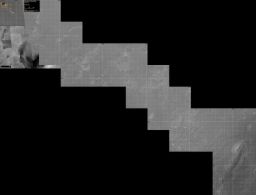 Opportunity route map
Opportunity route mapThis route map, compiled by Eduardo Tesheiner, shows the final route to Endeavour Crater, and Opportunity's travels through this month. The rover is now just under 6 kilometers away from Cape York, where she will begin her exploration of the 22-kilometer diameter crater. Credit: NASA / JPL-Caltech / UA / MSSS / E.Tesheiner
With 26,686.94 meters (26.69 kilometers, or 16.58 miles) on her odometer, she was sporting plenty enough power, 446 watt-hours, despite extremely dusty skies, registering 1.35 on the Tau scale of atmospheric opacity, and a solar array dust factor of 0.599.
On that same first sol in March, in one of those increasingly more frequent “isn’t-this-amazing” moments, the High Resolution Imaging Science Experiment (HiRISE) camera onboard the Mars Reconnaissance Orbiter (MRO) snapped a picture as Opportunity was extending her robotic arm. From orbit, the tracks she made approaching the crater from the west are clearly visible. Operated by the University of Arizona in Tucson, with Alfred McEwen the principal investigator, the HiRISE, was built by Ball Aerospace & Technologies Corp., in Boulder, CO.
Back down on Mars, however, as Opportunity's work continued that sol, Joint 2, her elbow joint, on her robotic arm or instrument deployment device ( IDD) stalled because of the long reach and small commanded motion. The rover has experienced this before, and according to her handlers a stall is anticipated when the IDD makes a long reach like that.
In any case, the rover engineers commanded Opportunity through a diagnostic maneuver on Sol 2525 (March 2, 2011) to confirm the health of the arm and joint and that all was okay, and it was. The rover then bumped 21 centimeters (8 inches) closer to the rock to shorten her IDD reach and to continue taking MI pictures for a close-up mosaicked picture of Ruiz Garcia.
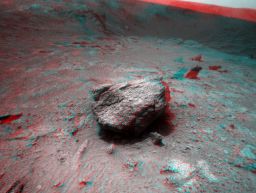 Ruiz Garcia in 3-D
Ruiz Garcia in 3-DOpportunity took this picture of Ruiz Garcia with its Pancam just this past weekend. The boulder, which looks to be a slate-bluish color, lies along the southeast rim of Santa Maria Crater. It's rugged and ragged and even sports a few of the famous Martian "blueberries" in its mix. This boulder wasnamed for one of the crewmembers on the first voyage of Christopher Columbus' Santa Maria back in 1492. Stuart Atkinson, of UnmannedSpaceflight.com, rendered it in 3-D. For more of Atkinson's work, poetry and musings, check out: http://roadtoendeavour.wordpress.com
Credit: NASA /JPL / Cornell / 3-D by S. Atkinson
Opportunity initially started to collect those MI pictures in late February, but experienced a problem when the instrument’s poker, which she was using to detect stand off distance, did not trip. The MI poker is used infrequently and it had been some time since it was last used. The glitch might have been because of the irregular rock surface, but the engineers decided to checkit out to make sure the switch is still functioning.
In any case, the Mössbauer spectrometer touch plate can be and is frequently used as a functional alternate for the MI poker and it was used this time around.
After collecting the MI images, the rover placed her alpha particle X-ray spectrometer (APXS) down on the target for multi-sol integration to wrap up her work at Ruiz Garcia.
As the second week of March began, Opportunity sent home telemetry that indicated her power levels had fluctuated down to 412 watt-hours, although the dusty skies got slightly less dusty and the Tau dropped a bit to 1.05. The rover's solar array dust factor registered at 0.5565. Given that the Martian spring is turning to summer, the time when the planet's notorious winds whip the powdery surface soils into the atmosphere this fluctuation is expected and no one on the team was expressing any concern about the rover's state of health and power.
On Sol 2531 (March 8, 2011), Opportunity backed away from Ruiz Garcia and drove about 8.7 meters (29 feet) to the north for the final wide-baseline stereo imaging with her panoramic cameras (Pancam), the last of her picture taking before leaving Santa Maria. That drive pushed the rover’s wheel odometry to 26,695.66 meters (26.70 kilometers, or 16.59 miles).
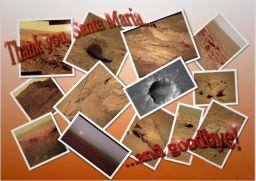 A farewell postcard from Santa Maria
A farewell postcard from Santa MariaOpportunity spent much of February and March at the football-field-size Santa Maria Crater. It is the youngest, and thus freshest crater the rover has visited to date. Although the decision was made not to enter the crater, the MER science team had the rover take a lot of Pancam images, with plans to create a 3-D model. Here is a picture postcard of some of the highlights, assembled by UnmannedSpaceflight.com's Stuart Atkinson.Credit: NASA / JPL / Cornell / UA / S. Atkinson
On Sol 2534 (March 11, 2011), Opportunity roved on to the imaging site, but after driving just about 2.7 meters (9 feet), a safety check stopped her in her tracks. When the team looked into it though the analysis showed that the rover was fine. The parameters of safety check are set to be cautious and in this case there was no untoward reason for the drive being halted.
Four sols later, just as the third week of the month began, the rover completed the final 2.7 meters (9 feet), pulling up to the first "eye" position for stereo imaging on Sol 2538 (March 15, 2011).
After completing her photography assignment there, Opportunity on Sol 2542 (March 19, 2011) drove 8.3 meters (27 feet) to the second and final "eye" location for the last stereo picture the rover would take of Santa Maria. From that vantage point, the rover spent several more sols collecting extensive Pancam pictures of the football-field-sized crater and its interior for this imaging campaign. The team is looking to use the pictures collected at Santa Maria to create a 3-D model of the youngest crater the rover has examined to date.
As the last week in March began, Opportunity’s energy moved back up to 453 watt-hours as the skies seemingly began to clear a bit as the Tau finally dropping below 1, to 0.986 With her work done at the crater, Opportunity pulled away from the rim on Sol 2545 (March 22, 2011). On the following sol drove due east for approximately 100 meters (328 feet), leaving Santa Maria in the rover's rear view mirror.
The rover veered off her charted southeast route to check out the last sizeable targets that appear to be between it and Endeavour. "We wanted to stop by and image some boulders of interest to the science team which were to the south of Santa Maria, however the best imaging we had was to the east," said Maxwell. "So instead of going straight southeast, we decided to go straight east first, and then south after that It turned out to be a clearer path, more free of obstacles, so that was a win overall."
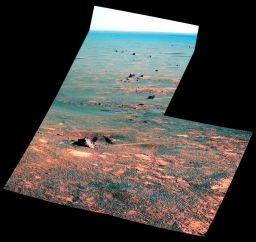 Santa Maria ejecta ray
Santa Maria ejecta rayOpportunity took this image of one of the ejecta rays emanating from Santa Maria Crater back in January 2011, on its Sol 2484. Rodrigo de Escobar is among the boulders in the ray. Pancam's 753nm, 535nm, and 432nm filters were used in the creation of this mosaic, which was rendered here in false color by the Pancam imaging team.Credit: NASA / JPL-Caltech / Cornell
On that drive, Opportunity moved in close to a big rock dubbed Rodrigo de Escobar and took pictures with her Pancam before heading onward. Then, last weekend, the rover cruised 114 meters (about 374.feet) to the south, as planned, a drive that put the rover near another boulder the team nicknamed Bagua.
Maxwell took the wheel on the rover's Sol 2551 (March 29, 2011) and guided Opportunity in backing up toward Bagua. "We did this nifty little trick where we backed up toward it and took some really good Pancam imaging in color, with both left and right eyes, then scooted away and headed down to the southeast and with imaging we had time for about 71.26 meters," (233.79 feet), he said.
"Everything is going swimmingly," said Maxwell. "The right front wheel currents were elevated a little bit when we were driving around Santa Maria, but it was kind of the logical because some of the drives we had to drive forward and driving forward always causes those wheel currents to be elevated. We were a little nervous about that because we're nervous every time the right front wheel currents go up. Fortunately, when we got back on the road and drove backwards as we have been to mitigate that issue, the right front wheel currents fell right back in line with the other wheel currents."
Yestersol, however, the right front wheel currents were once again slightly elevated as Opportunity drove just 39.39 meters (129.23 feet), maneuvering around the last of the boulders visible in the orbital images from HiRISE, to resume her southeast trek to Endeavour crater. "We need to take a look at that," said Callas. "It's an old rover. Remember, we haven't had an oil change in more than more years."
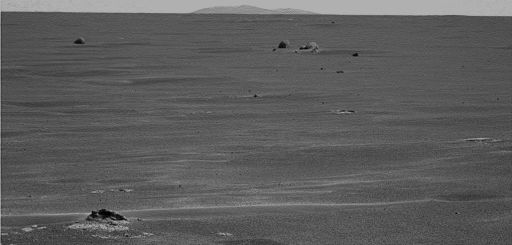 Less than 6 kilometers to go
Less than 6 kilometers to goThis is the latest picture of the Endeavour hills that Opportunity returned this month. The rover is now less than 6 kilometers (3.72 miles) away from the 22 kilometer (13.70 mile)diameter hole in the ground that is her next major destination.Credit: NASA / JPL-Caltech / Cornell / S. Atkinson
"The great thing about the drive to Endeavour – the first half of it was over the same kind of terrain Oppy had been in before with ripples and we had to be careful and we are now getting past that zone," said Maxwell.
"We're still seeing boulders and so we're still in the region where we see ejecta from Santa Maria, but we're heading out into pretty bleak terrain," clarified Squyres.
Today, on her Sol 2553, Opportunity drove out of March, heading toward April and Endeavour with a successful 90.13-meter (295.70-foot) drive, pushing her total wheel odometry to 27,125.76 meters (27.12 kilometers or 16.85 miles). What's really worth noting is the fact that mission success requirement from NASA was that one of the rovers achieve 600 meters of wheel odometry. "Spirit did that," Callas reminded, "and so technically the requirement for Opportunity was actually zero."
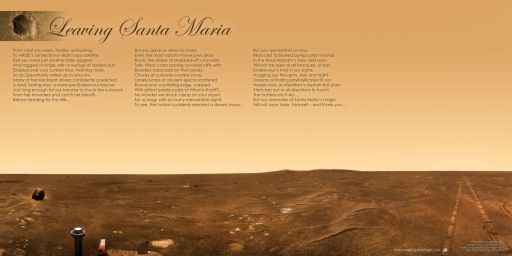 Leaving Santa Maria
Leaving Santa MariaStuart Atkinson romanticizes Opportunity's visit to and departure from Santa Maria Crater in words, and once again Glen Nagle has designed a poster for those words using an image produced by Michael Howard. We are proud to present "Leaving Santa Maria" here.Credit: NASA / JPL-Caltech / Cornell / poetry by S. Atkinson, image by M. Howard, poster design by G. Nagle
The Time is Now.
As a Planetary Defender, you’re part of our mission to decrease the risk of Earth being hit by an asteroid or comet.
Donate Today

 Explore Worlds
Explore Worlds Find Life
Find Life Defend Earth
Defend Earth


